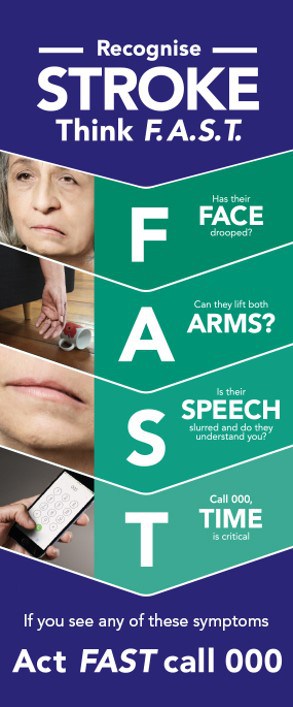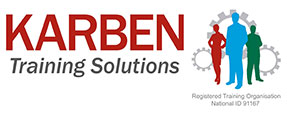FIRST AID ESSENTIALS
STROKE
A stroke occurs when the supply of blood to part of the brain is suddenly disrupted or when spontaneous bleeding from a blood vessel within the skull occurs. Approximately 80% of strokes are caused by an acute blockage of a blood vessel supplying part of the brain. If this blockage is rapidly cleared and blood supply restored, the amount of damage to brain tissue can be significantly reduced.
Stroke is a medical emergency.
Signs and symptoms
First aid providers can use stroke assessment systems such as FAST for individuals with suspected acute stroke. FAST is a simple way for remembering the signs of stroke:
- Facial weakness – can the person smile? Has their mouth or eye drooped?
- Arm weakness – can the person raise both arms?
- Speech difficulty – can the person speak clearly and understand what you say?
- Time to act fast – seek medical attention immediately – Call for an ambulance.
Other common symptoms of strokes include:
- Numbness of the face, arm or leg on either or both sides of the body
- Difficulty swallowing
- Dizziness, loss of balance or an unexplained fall
- Loss of vision, sudden blurred or decreased vision in one or both eyes
- Headache, usually severe and of abrupt onset or unexplained change in the pattern of headaches
- Drowsiness
- Confusion
- Reduced level of consciousness

This image is owned by © Stroke Foundation – Australia
Other common symptoms of strokes include:
- Numbness of the face, arm or leg on either or both sides of the body
- Difficulty swallowing
- Dizziness, loss of balance or an unexplained fall
- Loss of vision, sudden blurred or decreased vision in one or both eyes
- Headache, usually severe and of abrupt onset or unexplained change in the pattern of headaches
- Drowsiness
- Confusion
- Reduced level of consciousness
Management
When confronted with stroke the most important thing is to act FAST.
- Call an ambulance for any victim who has shown signs of stroke, no matter how brief or if symptoms have resolved.
- Do not give anything to eat or drink.
- Administer oxygen if available and trained to do so
- Provide reassurance.
- If the victim is unconscious but breathing lay victim on the side and ensure airway is clear
(ANZCOR Guideline 3). - If the victim is unresponsive and not breathing normally, commence resuscitation following
the Basic Life Support Flowchart (ANZCOR Guideline 8).
When there is a doubt over whether it is a stroke or other condition the victim should be managed as having a stroke until proven otherwise.
